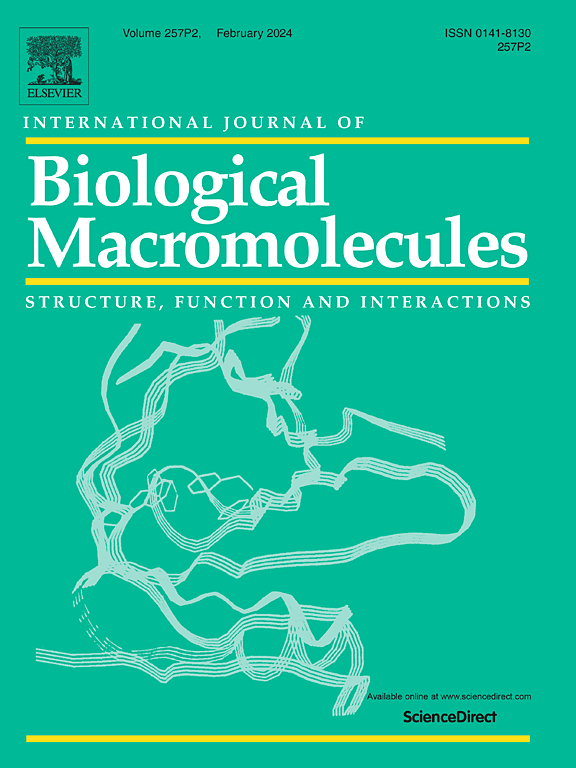可溶性形式的肿瘤坏死因子相关凋亡诱导配体与S100P蛋白相互作用
IF 8.5
1区 化学
Q1 BIOCHEMISTRY & MOLECULAR BIOLOGY
International Journal of Biological Macromolecules
Pub Date : 2025-05-01
DOI:10.1016/j.ijbiomac.2025.143667
引用次数: 0
摘要
肿瘤坏死因子(TNF)相关凋亡诱导配体(TRAIL)是一种肿瘤坏死因子超家族的治疗相关蛋白。膜结合和可溶性(sTRAIL)形式的TRAIL都影响先天和适应性免疫反应。我们最近发现,可溶性TNF与多功能钙结合蛋白S100家族的特定成员结合,导致其细胞毒活性受到抑制。生物医学学报,2014,23(24),15956。为了测试S100蛋白影响sTRAIL功能的能力,我们使用表面等离子体共振光谱、本征荧光、化学交联、分子模型、位点定向诱变、细胞毒性试验和生物信息学来研究人类sTRAIL与人类非融合S100蛋白的相互作用。在所检测的21个S100蛋白中,只有S100P蛋白与sTRAIL具有特异性相互作用,其平衡解离常数Kd达到(0.16±0.07)μM。在Ca2+存在下,sTRAIL单体与二聚体S100P严格结合,而在Ca2+存在下,sTRAIL三聚体与S100P二聚体相互作用。位点定向突变证实了S100P的“铰链”和c端区域参与了sTRAIL识别,与结构建模结果一致。生物信息学分析表明TRAIL和S100P在多种肿瘤中失调。S100P降低sTRAIL对人纤维肉瘤HT-1080细胞的细胞毒性。S100P蛋白对促凋亡sTRAIL信号的抑制可能参与了后者的致瘤作用。本文章由计算机程序翻译,如有差异,请以英文原文为准。
Soluble form of tumor necrosis factor-related apoptosis-inducing ligand interacts with S100P protein
Tumor Necrosis Factor (TNF)-Related Apoptosis-Inducing Ligand (TRAIL) is a therapeutically relevant protein belonging to the TNF superfamily. Both membrane-bound and soluble (sTRAIL) forms of TRAIL affect innate and adaptive immune responses. We recently showed that soluble TNF binds specific members of the S100 family of multifunctional calcium-binding proteins, leading to suppression of its cytotoxic activity (Int. J. Mol. Sci. 2022, 23(24), 15,956). To test the ability of S100 proteins to affect sTRAIL functioning, we used surface plasmon resonance spectroscopy, intrinsic fluorescence, chemical crosslinking, molecular modeling, site-directed mutagenesis, cytotoxicity assay, and bioinformatics to study interaction of human sTRAIL with human non-fused S100 proteins. Of the 21 S100 proteins examined, only S100P protein showed specific interaction with sTRAIL characterized by equilibrium dissociation constant, Kd, reaching (0.16 ± 0.07) μM. sTRAIL monomer binds dimeric S100P strictly in the presence of Ca2+, while sTRAIL trimer interacts with S100P dimer regardless of Ca2+. Site-directed mutagenesis confirmed involvement of the ‘hinge’ and C-terminal regions of S100P in the sTRAIL recognition, consistent with the structural modeling results. Bioinformatic analysis indicates dysregulation of TRAIL and S100P in various neoplasms. S100P lowers cytotoxicity of sTRAIL against human fibrosarcoma HT-1080 cells. The suppression of proapoptotic sTRAIL signaling by S100P protein may contribute to oncogenic effects of the latter.
求助全文
通过发布文献求助,成功后即可免费获取论文全文。
去求助
来源期刊
CiteScore
13.70
自引率
9.80%
发文量
2728
审稿时长
64 days
期刊介绍:
The International Journal of Biological Macromolecules is a well-established international journal dedicated to research on the chemical and biological aspects of natural macromolecules. Focusing on proteins, macromolecular carbohydrates, glycoproteins, proteoglycans, lignins, biological poly-acids, and nucleic acids, the journal presents the latest findings in molecular structure, properties, biological activities, interactions, modifications, and functional properties. Papers must offer new and novel insights, encompassing related model systems, structural conformational studies, theoretical developments, and analytical techniques. Each paper is required to primarily focus on at least one named biological macromolecule, reflected in the title, abstract, and text.

 求助内容:
求助内容: 应助结果提醒方式:
应助结果提醒方式:


